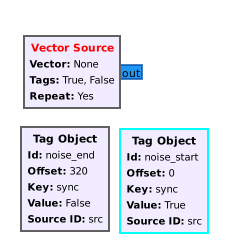Tag Object: Difference between revisions
Jump to navigation
Jump to search
No edit summary |
|||
| (One intermediate revision by the same user not shown) | |||
| Line 1: | Line 1: | ||
[[Category: | [[Category:Block_Docs]] | ||
This block creates a tag object. | This block creates a tag object. | ||
| Line 21: | Line 21: | ||
== Example Flowgraph == | == Example Flowgraph == | ||
[[File:Vector_source_with_tags.png]] | |||
== Source Files == | == Source Files == | ||
Latest revision as of 19:20, 29 November 2020
This block creates a tag object.
The tag objects are created using the python_to_tag Python function to make it easy to generate a tag_t in Python. The call looks like:
gr.tag_utils.python_to_tag(($offset, $key, $value, $src))
Parameters
(R): Run-time adjustable
- id (R)
- ID of the tag, can be used to reference it in other blocks.
- Offset (R)
- While tags are based on an absolute offset, this is based on a relative offset that must be appropriately translated by the block using it. For example, this is used by the vector_source blocks, which will treat a 0 offset in the tag as the first item in the stream when the vector starts or repeats.
- Key (R)
- Name of the tag.
- Value (R)
- Value to give to the tag (can be a number, a boolean or a string).
- Source ID (R)
- Name of the source of the tag, is sometimes used by certain blocks.
Example Flowgraph
Source Files
- C++ files
- TODO
- Header files
- TODO
- Public header files
- TODO
- Block definition
- TODO
